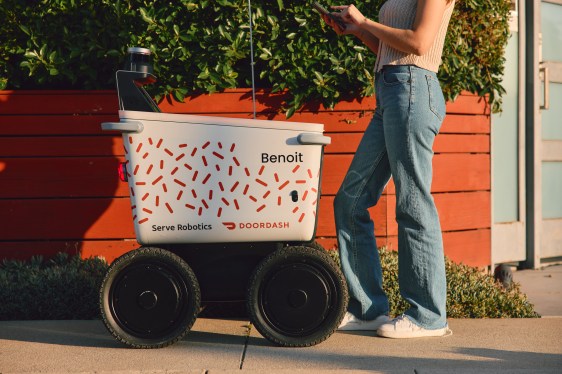DoorDash customers in Los Angeles might soon have their food delivered by one of Serve Robotics’ sidewalk delivery bots. The two companies announced a multi-year partnership to use autonomous robots for deliveries across the United States.
This new partnership follows the recent introduction of Dot, an autonomous food delivery robot built by DoorDash. Dot is first being deployed in the Phoenix area. Unlike Serve’s sidewalk-focused bots, Dot can travel on roads, bike lanes, and sidewalks at speeds up to 20 miles per hour.
Serve Robotics is the latest in a series of tech partnerships for DoorDash, which has also collaborated with sidewalk bot startup Coco and drone startup Wing. According to Ashu Rege, Vice President of autonomy at DoorDash Labs, this is part of a broader plan to become a platform for multimodal deliveries.
DoorDash is not the first app company to explore this path. Uber has also formed partnerships with autonomous vehicle companies across its various businesses, and Serve is one of those partners. Similar to gig workers, Serve’s bots will work with both Uber and DoorDash at the same time.
However, DoorDash is taking a different approach by developing its own delivery robot. Other companies have attempted a similar strategy. Both Uber and Lyft tried and failed to operate both the technology and the platform for autonomous ride-hailing. Autonomous vehicle startup Nuro also began with a vehicle similar to Dot before pivoting to licensing its technology after realizing manufacturing was too capital-intensive. These companies learned that it is more cost-effective to focus on their core technology.
Ashu Rege believes DoorDash will succeed where others have not. The company plans to manufacture Dot at scale, though specific details were not provided. DoorDash had its first profitable year in 2024 and reported record profits in the first half of 2025, driven by a 20 percent increase in delivery volumes. Rege argues the company needs more delivery methods to continue serving its growing customer base.
Rege also thinks Dot offers unique advantages. He stated that a gap exists between sidewalk robots and robotaxis, which are designed for moving people but do not solve the last-step delivery problem. A burrito will not walk itself to a customer’s door, and merchants do not want to retrieve a robot parked half a block away.
While sidewalk robots work well in dense urban settings, Rege said Dot is designed for dense suburban deliveries within a three to five mile range. Its ability to travel on both roads and sidewalks is a key feature.
A person can perform these tasks easily, but DoorDash says it plans to reserve its human workforce for more complex restaurant, retail, or grocery delivery trips.

